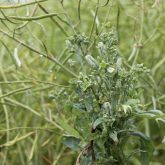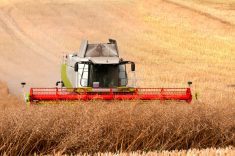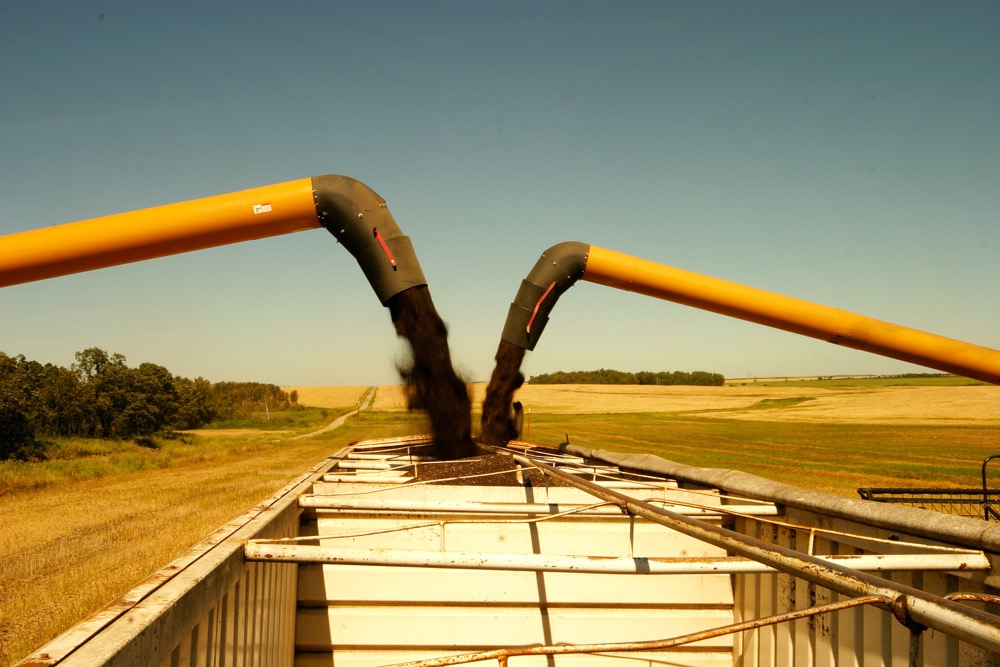Diamondback moths are in a deadly battle in canola fields — yet their primary adversary isn’t the grower. In fact, producers are learning to leave low populations of diamondback moth larvae alone because, in many cases, well-established beneficial insects will prevent the pest from becoming a major economic problem.
The main parasitoids of diamondback moth have been three tiny wasps, but the list keeps growing. Now, recent studies led by Lloyd Dosdall with the University of Alberta have identified another species, Cotesia vestalis, responsible for what is being called a very substantial level of total parasitism of diamondback moth larvae and many ground beetles that also prey on the pest.
Read Also

Could crop sharing be a viable option for your farm?
Crop sharing could be a good option for young and beginning farmers.
“Of all the insects in the environment, very few of them are significant crop pests,” says Keith Gabert, Canola Council of Canada agronomy specialist. “The more we study the insect fauna in our fields, the more we learn about our beneficial allies. An important first tip for insect management in canola is to always remember the beneficials.”
Sometimes leaving beneficials to do their job will save growers the cost of an early and unnecessary spray. But beneficials alone may not be enough to prevent economic loss from some insect outbreaks — which is why the first tip is certainly not the only tip.
“In some cases, beneficials cannot act fast enough to take down a rising threat. And in other cases, we may not have a strong beneficial population to counter some insects,” Gabert says. “That is why scouting and following economic thresholds have to be part of an insect management plan.”
- From the Grainews website: Integrated pest management
Here are 11 other insect management tips to follow throughout the canola-growing season:
- Scout for flea beetles. Fast-hopping flea beetles can move in quickly and cause economic losses within days. Seed treatments often provide enough protection, but they may not be sufficient if soils are cool, crop development is slow, and flea beetle numbers are high. If average leaf area loss is over 25 per cent, and the flea beetles are still present and feeding, then a spray may be necessary.
- Look for missing plants and patterns during your early-season flea beetle scouting. Cold soils, seedling diseases and deep seeding are among the many possible reasons for missing plants. Cutworms could also be at work. Use the diagnostic tool at www.canoladiagnostictool.ca for help with management decisions. “With a few calculations, you may also find that missing plants might not be ‘missing’ at all. The seeding rate might have been low to begin with,” Gabert says. “Count plants and check emergence rates before blaming insects or disease or cold soils.”
- Protect the bees. Bees and other pollinators are an important part of the ecosystem. They can improve crop yields, and bees give us honey. To protect bees while also protecting your canola crop, avoid spraying insecticide on flowering canola or at least spray after 8 p.m. when most bees are back in the hive. Take steps to minimize drift and, where possible, choose products with low potential hazard to bees. Stay in touch with your local beekeeper if beehives are in your area.
- Know the economic thresholds for all major insects, and try to spray only when those thresholds are reached. Most thresholds vary depending on canola prices and crop protection costs. “Also keep in mind that some insects — flea beetles or diamondback moth larvae, for example — can build up quickly and surpass thresholds within a day or two, in some cases,” Gabert adds. For more on thresholds, search for the article “Thresholds: Insect management tools” at www.canolawatch.org.
- Evaluate your sweep net technique. Thresholds for lygus bugs and cabbage seed pod weevils are based on accurate sweep netting. Use the standard 38-cm-diameter net, and make full 180-degree sweeps through the top of the canopy while walking forward. “Sweep netting is also a great way to see what other insects are present in the canopy,” Gabert says.
- Spray at the right time. Know the most vulnerable crop stage for each pest, and know the appropriate times to scout and take action. For cabbage seed pod weevil, for example, the goal is to stop adults from laying eggs in newly formed pods. Seed pod weevils don’t do their damage until pods are at least one inch long — so aim to spray just prior to that stage, at about 20 per cent bloom. Spraying seed pod weevil when canola is at the bud stage provides no economic benefit.
- Lygus bugs are most likely to cause economic loss when feeding in the period from late flowering to late pod formation. When sweep netting, include later instars — the ones with black dots on their back, soon to be adults — as well as adults in the count. Studies are underway to update the current thresholds. This insect pest tends to do less damage than expected when canola has adequate moisture.
- Bertha army worm can do a lot of damage in a couple days. Check provincial monitoring data for trap counts in your area, and check individual fields within moderate- to high-risk areas. Isolated outbreaks can occur. If field counts are close to threshold, keep looking. As Alberta Agriculture and Rural Development entomologist Scott Meers says, “If the action level is 20 per square metre and you find 17, look more closely to make sure you’re right.” Young bertha army worms can feed for weeks down in the canopy. Scouting long before worms reach full size and darken would give growers adequate time to assess if control is required.
- Learn to identify swede midge damage. Swede midge has been found in northeast Saskatchewan the past couple years, and the range is likely expanding. Economic thresholds are not established and we have no proven best timing for sprays. For 2014, the key message is to learn to identify swede midge damage. Damage typically includes one or more of the following:
- Distorted and twisted young shoots, and stunted growth, if damage is very early.
- Misshapen individual buds in a bud cluster.
- The primary raceme develops normally, but individual flowers are abnormal or only the flower stem and a small dried flower remnant remains.
- The primary raceme may be normal, but secondary branches may be stunted if infestation occurs later in flowering.
- Pods may form in a cluster because the growing point is damaged and stem elongation cannot occur.
- Pull up what look like diseased plants. Check roots for clubroot galls and, while looking, check for root maggots. An AAFC study has shown very clearly that with continuous canola, there is a statistically significant increase in root maggots. “Pulling up plants and checking the roots for maggot feeding, clubroot galls and other damage is an essential part of scouting and should be on every canola grower’s checklist,” Gabert says.
- Put your crop in the best position to succeed. Growers can reduce the risk of economic loss from insects, and reduce the need to spray pesticides, by starting the crop off with enough plants. “Canola needs a minimum of five plants per square foot to have good odds of reaching full yield potential. We recommend a stand of seven to 10, which allows for some insect feeding and some plant loss without reducing the yield potential,” Gabert says. “Having an adequate stand is an important first step in an integrated pest management strategy.”
Jay Whetter is editor of the Canola Council of Canada’s free Canola Watch agronomy newsletter. Sign up at www.canolawatch.org and follow @CanolaWatch on Twitter. To read a summary of Lloyd Dosdall’s beneficial insect studies, see the Canola Digest Science Edition 2013 here. Look for studies 6.2 and 7.1.















